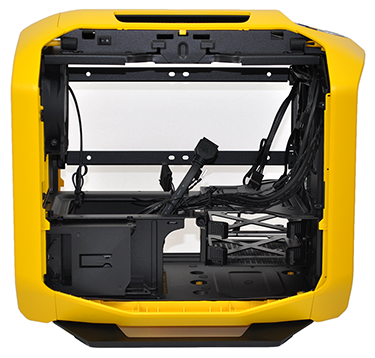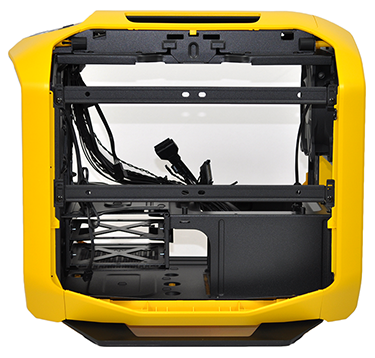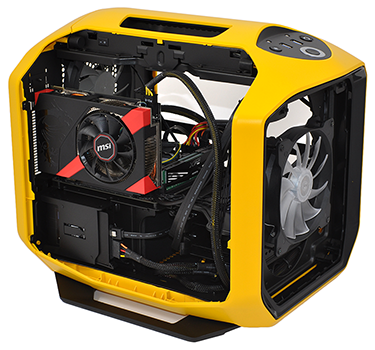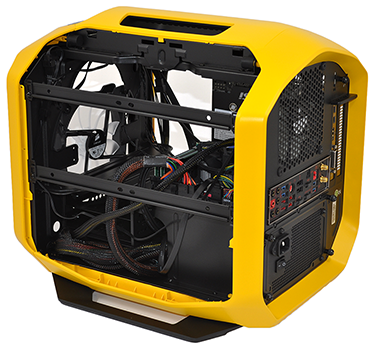Inside the Graphite Series 380T
Easy access is a hallmark feature of high-end Graphite Series enclosures, and the 380T is no exception. Corsair has implemented quick-release side panels that curve at the top and bottom to effectively wrap around the case. The mechanism works well and the doors are primarily mesh, enabling a plentiful supply of air. The only exception is the upper curved section, which is windowed to provide a glimpse of the inner components.
The idea is good, but the windowed section just isn't big enough - users who really want to show off their build are going to want a completely Perspex panel, and we hope Corsair makes one available as an optional extra. Such a panel would do a better job of showcasing the underlying hardware, and though it may reduce airflow, it would have the added benefit of minimising dust build-up.
Taking off both side panels reveals an internal layout that isn't too dissimilar to the Obsidian Series 250D. The Mini-ITX motherboard tray lays horizontally on top of the PSU bay, and airflow maintains a simple front-to-back route. The key difference between the two is that the baby Graphite uses plenty of plastic moulding, meaning it doesn't have the premium, high-quality feel of the Obsidian option.
Corsair provides two fans as standard - a 140mm front intake with white LEDs and a rear 120mm exhaust - though there's a reasonable amount of room for expansion beyond the default configuration. The front intake can be upgraded to a larger 200mm unit (or dual 120s, if you prefer), and the side rails you see in the above pictures provide two further 120mm mounts. These, of course, are implemented specifically with a 240mm radiator in mind.
What's handy is that a three-step fan controller is included as standard. Supporting a trio of fans, the SATA-powered controller alleviates any concerns of limited fan headers on Mini-ITX boards, and the three available profiles make it easy to switch between quiet or performance modes.
Elsewhere, we can see two 3.5in hard-disk trays, two 2.5in SSD bays and a strange-looking on/off button positioned inside the case just below the carry handle. This switch toggles a single white LED positioned on the chassis' ceiling - it's there, presumably, to make it easier to locate motherboard connectors.
Our Mini-ITX test build consists of an MSI Z97I Gaming AC motherboard, 16GB of Adata XPG DDR3 memory, an MSI Radeon R9 270X Gaming 2G ITX graphics card, a Corsair Force 120 SSD and a Corsair CX430 power supply.
All of the components went in with relative ease, but do be aware that Mini-ITX builds aren't as forgiving as traditional towers. The power supply, for example, has to be installed from the outside and secured with a supplied bracket, and given the location of the 3.5in drive trays, there isn't a great amount of room for PSU cabling. If you're using a modular unit, Corsair suggests attaching the cables prior to installation - that's because you'd have a hard time accessing the ports later on. PSU length is also limited to 160mm, so larger enthusiast supplies aren't recommended.
Cable management is another thing that will need careful consideration. There's just about enough room in and around the 3.5in drive trays to store excess cabling (there are multiple tie-down points on the floor of the case), but given the horizontal motherboard layout, a fair few cables need to travel up and over, making it difficult to keep the build ultra-neat and tidy.
Our sample build leaves large parts of the internal cavern looking sparse, and those in the market for an ultra-compact enclosure will argue that the 380T should have been smaller. The reasoning behind Corsair's chosen dimensions, however, is quite clear: the chassis retains support for a long graphics card (up to 290mm in length) as well as a 240mm radiator. But if you're planning on using such components in a small-form-factor build, is the 380T the best choice?













